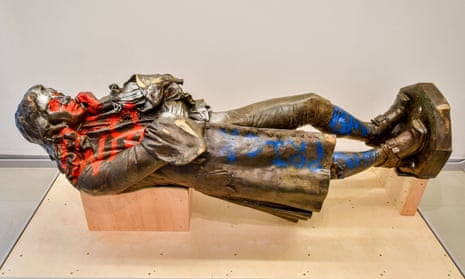Last week’s We Are Bristol History Commission report into the toppling of Edward Colston’s statue made fascinating reading, not least because it put a credible number on the strength of feeling on either side of the most heated “culture war” – among those who wanted the statue toppled and those outraged by the act.
Nearly 14,000 people, more than half from Bristol, responded to the commission’s invitation to complete a detailed survey on their feelings about the events of June 2020. Three-quarters agreed with the idea that the slave trader’s statue should remain on permanent display in a Bristol museum, while only 12% thought it should be restored to its plinth. Those who believed it should be seen horizontally and graffitied, in the state it was recovered from the harbour, outnumbered those who believed it should be cleaned and upstanding by five to one.
Some of the best reactions, however, came from those respondents who offered compromise solutions, novel ways of keeping both statue-dunkers and pearl-clutchers happy. One of these suggested that the statue be split in two, “with one half of it returned to the plinth and the other half thrown back in the river”. Best of all, perhaps, was the proposition that “(after updating the plinth with an accurate plaque) we put Colston back up. Then once every year on the anniversary of his toppling we have a festival where we pull him down again and ceremonially throw him in the river.” What’s not to like?
You do the maths

In 1980, Stephen Hawking was confident that a “final unified theory” of “life, the universe and everything” would be found in the next two decades. At a conference that year he assembled the theoretical physicists who seemed closest to establishing the idea of “supersymmetry”, linking the very smallest particles in the universe with the very largest forces. A blackboard from that conference, which preserves the doodlings of some of the world’s greatest minds, went on display last week in a new Hawking exhibit at the Science Museum in London. That it contains not killer equations but a series of crap in-jokes about the participants at the conference confirms my own unified theory: that Douglas Adams’s Hitchhiker books had nearly as much to say about our ultimate place in the cosmos as those of his more illustrious contemporary.
Get down on it

Having started and abandoned a doomed series of “must get fit” regimes – couch to 5k and quickly back to couch – I thought I had stumbled on an inspired solution to my horribly sedentary work habits a month or two ago. My plan was this: every time I felt I was losing concentration in staring at my working-from-home screen – about every 17 minutes – I’d activate a favourite (alarmingly 1980s) playlist and dance around the kitchen island like nobody was watching for a couple of tracks, before returning to my desk.
The tactic seemed, and still seems, so promising on several levels – quick burst of endorphins, no Lycra or Peloton required, embarrassing only to immediate family – that I believed I might have discovered a unique health breakthrough. Inevitably, however, there’s a book that shows I’m far from a pioneer. Dr Peter Lovatt’s The Dance Cure promises to provide “the surprising secret to being smarter, stronger, happier”.
He assembles all sorts of disciples – from Captain Cook to Virginia Woolf to Debbie Harry – to evangelise versions of my intermittent boogie wonderland. “Let us read and let us dance,” Voltaire insisted. “These two amusements will never do any harm to the world!”

